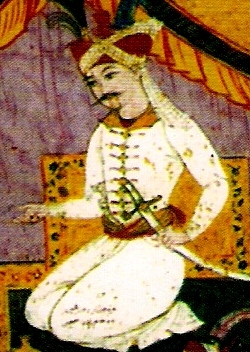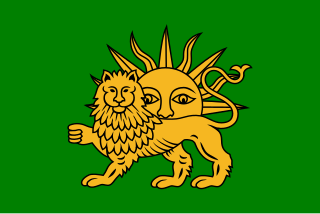
Tahmasp I was the second shah of Safavid Iran from 1524 until his death in 1576. He was the eldest son of Ismail I and his principal consort, Tajlu Khanum. Ascending the throne after the death of his father on 23 May 1524, the first years of Tahmasp's reign were marked by civil wars between the Qizilbash leaders until 1532, when he asserted his authority and began an absolute monarchy. He soon faced a long-lasting war with the Ottoman Empire, which was divided into three phases. The Ottoman sultan, Suleiman the Magnificent, tried to install his own candidates on the Safavid throne. The war ended with the Peace of Amasya in 1555, with the Ottomans gaining sovereignty over Iraq, much of Kurdistan, and western Georgia. Tahmasp also had conflicts with the Uzbeks of Bukhara over Khorasan, with them repeatedly raiding Herat. In 1528, at the age of fourteen, he defeated the Uzbeks in the Battle of Jam by using artillery.

Ismail I was the founder and first shah of Safavid Iran, ruling from 1501 until his death in 1524. His reign is often considered the beginning of modern Iranian history, as well as one of the gunpowder empires. The rule of Ismail I is one of the most vital in the history of Iran. Before his accession in 1501, Iran, since its conquest by the Arabs eight-and-a-half centuries earlier, had not existed as a unified country under native Iranian rule. Although many Iranian dynasties rose to power amidst this whole period, it was only under the Buyids that a vast part of Iran properly returned to Iranian rule (945–1055).

The Battle of Chaldiran took place on 23 August 1514 and ended with a decisive victory for the Ottoman Empire over the Safavid Empire. As a result, the Ottomans annexed Eastern Anatolia and northern Iraq from Safavid Iran. It marked the first Ottoman expansion into Eastern Anatolia, and the halt of the Safavid expansion to the west. The Chaldiran battle was just the beginning of 41 years of destructive war, which only ended in 1555 with the Treaty of Amasya. Though Mesopotamia and Eastern Anatolia were eventually reconquered by the Safavids under the reign of Shah Abbas the Great, they would be permanently ceded to the Ottomans by the 1639 Treaty of Zuhab.

The Russo-Persian War of 1722–1723, known in Russian historiography as the Persian campaign of Peter the Great, was a war between the Russian Empire and Safavid Iran, triggered by the tsar's attempt to expand Russian influence in the Caspian and Caucasus regions and to prevent its rival, the Ottoman Empire, from territorial gains in the region at the expense of declining Safavid Iran.

Farrukh Yasar was the last independent Shirvanshah of Shirvan (1465–1500). In 1500, the first Safavid ruler, Ismail I, decisively defeated and killed Farrukh Yasar during his conquest of the area. Descendants of Farrukh Yasar continued to rule Shirvan under Safavid suzerainty, until 1538, when Ismail's son and successor Tahmasp I appointed its first Safavid governor, and made it a fully functioning Safavid province.

Ismail II was the third Shah of Safavid Iran from 1576 to 1577. He was the second son of Tahmasp I with his principal consort, Sultanum Begum. By the orders of Tahmasp, Ismail spent twenty years imprisoned in Qahqaheh Castle; whether for his recurrent conflicts with the realm's influential vassals, or for his growing popularity between the Qizilbash tribes, resulting in Tahmasp becoming wary of his son's influence.

Mohammad Khodabanda, was the fourth Safavid shah of Iran from 1578 until his overthrow in 1587 by his son Abbas I. Khodabanda had succeeded his brother, Ismail II. Khodabanda was the son of Shah Tahmasp I by a Turcoman mother, Sultanum Begum Mawsillu, and grandson of Ismail I, founder of the Safavid dynasty.

The Shirvanshahs were the rulers of Shirvan from 861 to 1538. The first ruling line were the Yazidids, an originally Arab and later Persianized dynasty, who became known as the Kasranids. The second ruling line were the Darbandi, distant relatives of the Yazidids/Kasranids.
Murād Mīrzā was the 36th Imam of the Nizari Isma'ili Shi'a Muslim community.

Safavid Iran or Safavid Persia, also referred to as the Safavid Empire, was one of the largest and long-standing Iranian empires after the 7th-century Muslim conquest of Persia, which was ruled from 1501 to 1736 by the Safavid dynasty. It is often considered the beginning of modern Iranian history, as well as one of the gunpowder empires. The Safavid Shāh Ismā'īl I established the Twelver denomination of Shīʿa Islam as the official religion of the empire, marking one of the most important turning points in the history of Islam.

The siege of Tabriz took place in 1501 just after the Safavids had defeated the Aq Qoyunlu in the Battle of Sharur. In the preceding battle the Safavids were able to defeat the Aq Qoyunlus that had an army which was 4 times bigger than the Safavid army. After the siege Ismail I chose Tabriz as his capital and proclaimed himself Shahanshah of Iran.

Sheykh Ibrahim II was the 40th shah of Shirvan.

The Jalali Castle is located in Kashan, Iran.

The conquest of Shirvan was the first campaign of Ismail, the leader of the Safavid order. In late 1500, Ismail marched into Shirvan, and, despite heavily outnumbered, decisively defeated the then incumbent Shirvanshah Farrukh Yassar in a pitched battle, in which the latter and his entire army were killed. The conquest resulted in the toppling of the Shirvanshahs as autonomous rulers, who had ruled large parts of the Caucasus for centuries, and the incorporation of their domain.

Selim I, known as Selim the Grim or Selim the Resolute, was the sultan of the Ottoman Empire from 1512 to 1520. Despite lasting only eight years, his reign is notable for the enormous expansion of the Empire, particularly his conquest between 1516 and 1517 of the entire Mamluk Sultanate of Egypt, which included all of the Levant, Hejaz, Tihamah and Egypt itself. On the eve of his death in 1520, the Ottoman Empire spanned about 3.4 million km2 (1.3 million sq mi), having grown by seventy percent during Selim's reign.
Bahram Mirza Safavi was a Safavid prince, governor and military commander in 16th-century Iran. He was the youngest son of Shah Ismail I, the founder of the Safavid dynasty.

The Baghdad Province was a province of the Safavid Empire, centred on the territory of the present-day Iraq. Baghdad was the provincial capital and the seat of the Safavid governors.
The Battle of Sharur occurred in July 1501. It ended with a decisive victory for the Safavid army. After this victory, the way of the Safavids to Tabriz was opened. Alvand Mirza disappeared from the political scene.

Murad's Gate is a large portal located in the eastern wall of the Shirvanshahs’ Palace complex central courtyard. It is the only building of the 16th century on the territory of the complex.

Gulustan Fortress or Castle is a medieval castle dating back to the 9th-12th centuries located in Shamakhi District of Azerbaijan. Although the oldest archeological findings from the castle date back to the 9th century, the Gulustan castle was radically rebuilt and strengthened in the 12th century - the beginning of the 13th century.
















